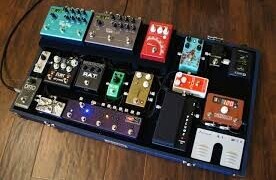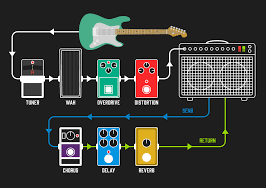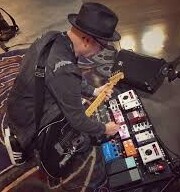
Guitar pedal boards are like the unsung heroes holding your favorite effects all in one place. They make sure everything’s organized and ready to go, whether you’re practicing in your bedroom or about to smash it onstage.
Pedal boards have come a long way from being just DIY wooden slabs. Nowadays, they’re sleek, durable, and packed with features. Think fewer wires getting tangled and more reliability when you need it most. These boards let you focus on your sound without sweating the small stuff.
Using a pedal board means more than just convenience; it amplifies your performance. Imagine switching effects seamlessly without missing a beat; that’s what a well-set-up board can do for you.
You’ve got choices when it comes to boards: custom-built to fit your every need or ready-made options that are plug-and-play. Going custom means you can create a setup that feels like it’s an extension of you, while ready-made ones are great for those who want something straightforward right out of the box.
Setting Up Your Pedal Board: Building Blocks and Essentials
Picking the right size and type of pedal board is all about knowing what you need. Got a hefty collection of pedals? You’ll be looking at something more like an aircraft carrier than a dinghy. Smaller setups, meanwhile, keep things light and focused for those who prefer simplicity.
Power supplies are the backbone of your pedal board. Without a reliable one, the setup might leave you in the lurch during a crucial riff. Aim for something quiet and roadworthy that’ll keep your pedals humming without adding any unwanted noise.
Connecting everything can feel like piecing together a puzzle. Good cables and connectors make sure your signal flows smoothly, cutting out static and ensuring clarity. Saving some time here can save loads of frustration during a gig.
The order of your pedals plays a huge role in shaping your sound. Think about what you want upfront—a tuner, maybe—and how you want effects to stack. This is where your personal touch really shines, allowing you to craft unique tones that are all yours.

Keeping your pedals arranged neatly and securely isn’t just about looks. It’s about efficiency and safety. Fasten them down with Velcro or ties, and make sure everything’s within reach. This could save you from unnecessary accidents when you’re right in the zone.
Exploring Diverse Pedal Types: Unleashing Creativity
Pedals come in all shapes and sizes, each bringing its own flavor to your sound. Whether you’re after that crunchy distortion, shimmering modulation, or delay messages, there’s a pedal out there ready to help you shine on stage.
Effects pedals are your playground. From overdrive to wah-wah, these gadgets can completely transform your guitar’s personality. They work wonders for setting emotional tones or adding layers to your songs.
Distortion pedals, on the other hand, can push your sound to gritty new heights. A good distortion pedal can be the difference between a dull performance and one that’s downright explosive, giving you that edge seasoned musicians swear by.
Modulation pedals—think chorus, flanger, or phase shifters—open up a world of sonic texture. They breathe life into your tunes, adding depth and movement that captivate listeners and keep them engaged.
If experimentation is your thing, why not dive into delay and reverb pedals? These babies stretch your sound across time and space, creating ambient soundscapes and echoing sequences that narrate emotion like nothing else.
Picking the right pedals often ties back to your music genre. Blues enthusiasts might opt for warm overdrives, while metalheads could be hunting for aggressive, growling distortions.
Technology has taken modern pedals to the next level. Many offer programmable features, presets, and MIDI capabilities for ultimate control. These innovations mean you can switch up your entire sound with just a stomp, all without missing a beat.
Maintenance and Optimization: Ensuring Longevity and Performance

Keeping your pedal board in top shape is key to making sure you get the best sound, gig after gig. Routine checks and a little TLC can go a long way in preventing hiccups during your performances.
Start by giving your board a regular once-over. Dust those pedals off, check for any loose wires, and get rid of that grime that loves to collect on well-loved gear. A clean board isn’t just about looks—it’s about ensuring everything functions flawless.
Troubleshooting common issues like noise or faulty connections can be a breeze when you know what to watch for. Always use quality cables and power supplies to cut down on hum or buzz. And if something seems off, test each component individually before you panic.
With tech’s rapid advance, you can optimize your board with MIDI integration or even wireless setups. These can offer smoother transitions between effects and reduce messiness on stage.
For those looking to elevate their performance even more, try experimenting with advanced setup techniques, like dual amp configurations or stereo setups. These can bring your live shows to the next level, offering rich, immersive sound that envelops the audience.
Expert tips are worth their weight in gold. Listen to advice on how to stack your pedals for optimal sound, or buffer your signals for clearer tone delivery. The more you learn about crafting your sound, the more confidence you have each time you play.
